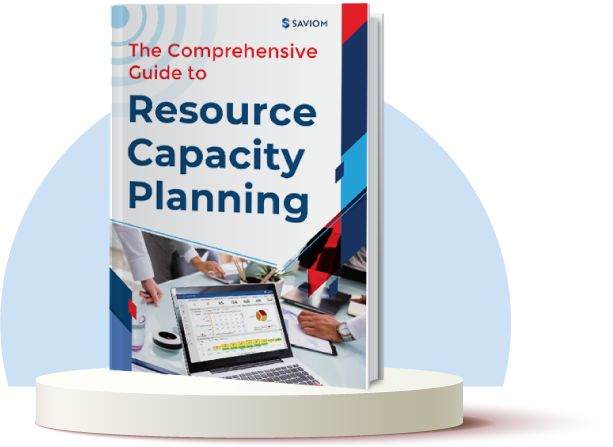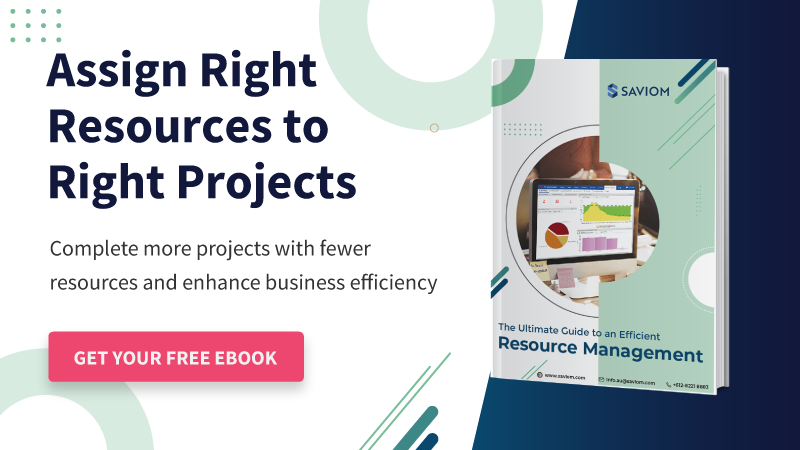As a project manager, you’ve likely encountered situations when your projects sit in the grey area between success and failure. For instance, your project might have stayed within budget but missed its timeline, or perhaps it met the deadline at the cost of team burnout. In such scenarios, the lack of performance tracking against variables like cost and time often contributes to project failure despite meticulous planning. So, if you are looking for more definitive goals for project success, you must use Earned Value Management or EVM.
EVM provides a clear picture of ‘where a project stands’ and ‘how far the journey is ahead.’ This accuracy helps spot discrepancies, change plans, correct mistakes, and make timely yet quality delivery possible. Moreover, it integrates cost and time – two diverse yet crucial factors on a unified scale and lets you compare the execution against the plan.
This way, earned value management brings you closer to precision in project planning and accuracy in performance for unmatched process delivery. It empowers you to define responsibilities without burning out your team members and provides stakeholders with clarity regarding progress.
This article will cover the essential aspects of earned value management and the steps to implement it in project management.
Let’s begin with the definition of earned value management.
What is Earned Value Management?
Earned value management is a project management methodology that integrates schedule, costs, and scope to compare the planned vs. actual and identify variances. This system helps managers systematically measure project performance against the baseline.
EVM uses key metrics like Planned Value (PV), Earned Value (EV), and Actual Cost (AC) to spot discrepancies and rectify them for timely delivery within budget. It also helps forecast future performances and outcomes, enabling project managers to adjust accordingly.
When to Use Earned Value Analysis in Project Management?
Earned value analysis (EVA) is typically used in complex, large-scale projects with significant budgets and longer timelines. This method helps break down the complexity by providing a clear picture of cost and schedule performance, making tracking progress easier. It helps in accurate performance tracking against the established baseline, enabling managers to identify deviations and take corrective measures.
EVA is particularly useful in projects with fixed budgets or strict deadlines. It helps identify cost overruns or schedule delays early, preventing potential issues from escalating. For resource-intensive projects, it helps optimize resource allocation and utilization, preventing overburdening the team or compromising quality. Lastly, EVA offers transparent and data-driven updates to project stakeholders, boosting trust and accountability.
Let us now explore the core components of earned value management (EVM).
Core Components of EVM
Earned value management systems comprise various key elements. Let’s take a look at them:
Planned Value (PV)
Planned value (PV) is the cost of the work that should be completed by a specific time. It can apply to the entire project or a specific timeframe, such as days or weeks. Planned value helps in tracking whether the project is progressing as planned.
Earned Value (EV)
Earned value (EV) represents the work accomplished at a certain point in the project compared to planned work. It reflects the budgeted cost of completed work and provides a precise measure of progress by comparing the value earned to the scheduled value.
Actual Cost (AC)
The actual cost (AC) reflects the expenditure incurred for the work completed. It provides the actual cost of project execution to compare against planned and earned values. It includes all the costs associated with the project, such as labor, materials, equipment, and overhead expenses.
Budget at Completion (BAC)
The budget at completion (BAC) defines the total approved funding for the project or a specific task. It is the financial baseline for measuring variances and forecasting project completion costs. It also helps managers to understand total expected expenses and perform profitability analysis.
Read More: How to Develop an Effective Project Budget in 8 Simple Steps?
Estimate at Completion (EAC)
The estimate at completion (EAC) calculates the revised total cost of the project based on current performance metrics. It helps project managers to identify cost overruns and address budget issues early on. Moreover, it enables project managers to communicate with stakeholders about escalating expenses proactively.
Estimate to Complete (ETC)
The estimate to complete (ETC) measures the cost, time, and resources needed to finish the remaining work. It considers the project’s current status, any changes, and potential risks. Thus, it determines if a project is on track and allows for proactive budget planning for the rest of the project.
Performance Indices Thresholds
The two performance indices thresholds are the cost performance index and the schedule performance index. CPI measures budget efficiency by comparing the value of completed work to actual project costs. At the same time, the SPI evaluates if the project is on track by comparing completed work to planned progress.
Variance Analysis
It compares planned performance with actual results, using cost variance (CV) and schedule variance (SV) to identify deviations in cost, schedule, and scope. This helps project managers evaluate if the project is on track, ahead of schedule, behind schedule, under budget, or over budget, and take corrective actions beforehand.
Read More: 5 Ways to Reduce Project Management Costs
The following section explains these components of earned value management through a detailed example.
Earned Value Management Example
Let’s take the example of a construction firm planning to build a new office building. The total project budget, or Budget at Completion (BAC), is $1,000,000, and the planned duration is 12 months. By the end of Month 6, the firm expected to complete 50% of the work, meaning the Planned Value (PV) is:
PV = $1,000,000 × 50% = $500,000.
However, upon review, only 40% of the work has been completed. This gives the Earned Value (EV):
EV = $1,000,000 × 40% = $400,000.
At the same time, the firm has already spent $600,000, which represents the Actual Cost (AC).
Now, let’s calculate the key metrics to evaluate the project’s performance. First, the Cost Performance Index (CPI), which measures cost efficiency, is:
CPI = EV ÷ AC = $400,000 ÷ $600,000 = 0.67.
A CPI of less than 1 indicates that the project is over budget. Next, the Schedule Performance Index (SPI), which assesses schedule efficiency, is:
SPI = EV ÷ PV = $400,000 ÷ $500,000 = 0.8.
An SPI of less than 1 shows the project is behind schedule. Additionally, the Cost Variance (CV), which highlights cost deviation, is:
CV = EV – AC = $400,000 – $600,000 = -$200,000.
The negative CV confirms overspending. Lastly, the Schedule Variance (SV), which measures schedule deviation, is:
SV = EV – PV = $400,000 – $500,000 = -$100,000.
This negative SV reveals that the project is also behind schedule. These calculations demonstrate that the project is over budget and delayed, providing clear insights to identify inefficiencies and make necessary adjustments to steer the project back on track.
Now, let us look at the crucial members involved in the EVA process.
Key Participants in the Earned Value Analysis Process
The earned value analysis (EVA) process involves key participants who ensure project performance is accurately tracked for successful outcomes. Let’s have a closer look at them:
Project Manager
Project managers are the central figure responsible for overseeing the entire EVA process. They define the project scope, budget, and schedule baselines and ensure accurate tracking of metrics such as planned value (PV), earned value (EV), and actual cost (AC). This analysis helps them identify variances, implement corrective actions, and communicate progress to stakeholders.
Project Control Officer/Analyst
Project control officers collect, analyze, and report the data required for effective earned value analysis. They develop and update performance baselines for scope, schedule, and cost. Furthermore, they track and calculate EVM metrics like CPI, SPI, and EAC, perform variance analysis, identify discrepancies, and provide detailed reports to the project manager.
Project Team Members
Project team members are responsible for completing the tasks, providing updates on progress, and delivering project tasks after completion. They report the percentage of work completed for the assigned task data and collaborate with the project manager to ensure that work aligns with baselines. Lastly, they are responsible for identifying potential delays and communicating them early.
Finance/Accounting Team
The finance or accounting team tracks the project’s actual costs, ensuring that spending is recorded accurately. They also check whether the project spending aligns with the original budget. Moreover, they assist in forecasting future costs (EAC) and flag potential overruns or inconsistencies in expenditure.
Stakeholders/Project Sponsors
Project stakeholders and sponsors are the ones who are directly impacted by the project’s performance and outcomes. They evaluate EVA reports to assess project progress, and ensure it aligns with expectations. Lastly, they approve necessary adjustments and provide strategic input to ensure project success.
Read More: Who are Project Stakeholders and How to Manage Them Efficiently?
Now that we understand the key members, let’s explore the various benefits of earned value management (EVM).
Importance of Earned Value Management
Earned value management provides a comprehensive picture of the project’s performance and progress. Let us look at some of the essential advantages of using EVM.
Measures Schedule and Budget Accuracies
Surprises can come at any point during the project lifecycle. There can be changes in project scope, client priorities, and unforeseen roadblocks. Accordingly, the schedule and budget might deviate from the project plan. What happens when you realize after completing 80% of the project that you exhausted the budget but managed to stick to deadlines?
To avoid such partial failures, you can calculate and implement schedule variances (SC) and cost variances (CV) as mentioned above. Measuring these variances at every milestone helps mitigate damages. It also helps to take precautionary measures to bring the CV level to zero.
Anticipates Risks & Allows Intervention Early
As part of the earned value management process, stakeholders are alerted about problems that can put the project at risk throughout its lifecycle. It enables them to make adjustments to prevent the project from deviating from the original plan. Some of these modifications include tweaking project scope and budgets, procuring more resources, investing in better technologies, and more.
With metrics such as estimate at completion (EAC) and estimate to complete (ETC), managers can gain insights into future performance and costs. For example, if the CPI level is below 1, it highlights inefficiencies in spending. Accordingly, managers can intervene and take early action before experiencing any setbacks.
Read More: Risk Matrix in Project Management: An Ultimate Guide
Enhances Accountability and Motivation
Earned value analysis provides better clarity and control of the activities involved, enabling project managers to respond to issues early. As a part of EVM, employees need to track their time and report their progress against the baseline. It motivates top performers to keep up the extra effort and encourages the ones lagging to pick up the pace and match their coworkers’ output.
Moreover, as mentioned above, performance indexes like SPI and CPI show if your project is within the budget and proposed timeline. For example, knowing 50% of the project is completed will keep them motivated, and they look forward to the product launch. During portfolio analysis, this clarity helps stakeholders assess which projects are more likely to succeed.
Improves Stakeholder Communication & Reporting
Earned value management (EVM) ensures strong communication by providing stakeholders with clear, quantifiable project updates. Metrics like cost performance index (CPI) and schedule performance index (SPI) offer straightforward insights to evaluate progress. These reports ensure everyone stays informed about project health without ambiguity.
Moreover, EVM establishes a structured reporting framework that aligns with stakeholder needs. For instance, high-level summaries provide a quick project overview to executives, while more detailed reports provide managers and team leaders with actionable data. This categorization ensures that each audience receives the right data, minimizing information clutter and enhancing decision-making.
Read More: Why Project Communication Skills are Important, and How to Master Them?
Supports Benchmarking & Drives Continuous Improvement
Earned value management (EVM) provides a solid foundation for analyzing project performance against benchmarks and identifying areas of improvement. By tracking key metrics like cost and schedule variance, EVM highlights gaps between planned and actual progress. These insights allow teams to mark standards as valuable references for future projects.
Moreover, EVM promotes continuous improvement of performance trends, which helps refine project management strategies over time. Managers can leverage EVM data to evaluate past project successes and failures and accordingly refine the lessons learned reports. Over time, this systematic approach leads to better resource allocation and improved workflows, ultimately leading to better project outcomes.
We have covered the importance of earned value management. Up next, we shall discuss the essential metrics and formulae used in EVM.
Earned Value Management Metrics & Formulas
Project managers analyze the project’s schedule and cost performances with EVM based on the following crucial indicators:
Schedule variance (SV)
Schedule variance is the difference between the actual work done (EV) and the work planned to be completed (PV). It indicates if the project is ahead of schedule, on or behind schedule.
SV =
0 variance means the project is on schedule, whereas negative or positive variance means it is behind and ahead of schedule.
Cost variance (CV)
It is the difference between the value earned and the actual cost. It shows if the project is within budget or not using the following formula:
CV =
0 variance means the project is adhering to the approved cost. Negative and positive variance indicates the project is going over and under the budget, respectively.
Schedule performance index (SPI)
SPI is the ratio between the earned value and the planned value. It is a relative measure of the project’s time efficiency using the formula:
SPI =
If the value of SPI is greater or equal to 1, it means the project is on track, whereas less than 1 indicates a deviation from the scheduled project budget.
Cost performance index (CPI)
It is the ratio of earned value to actual cost. In other words, the CPI equals the earned value divided by the actual costs. PMI’s PMBOK® Guide defines the CPI as a “measure of cost efficiency on a project.”
CPI =
It is a relative measure of the project’s cost efficiency and can estimate the remaining task’s cost.
To-Complete Performance Index (TCPI)
The to-complete-performance index (TCPI) is a forecast that shows the efficiency required to complete the remaining work within the approved budget. The formula used to calculate it is:
TCPI =
A TCPI greater than 1 means the project needs to perform better than its current cost performance to stay within budget.
Variance at Completion (VAC)
Variance at completion (VAC) estimates the difference between the budget at completion (BAC) and the estimate at completion (EAC). The formula used to calculate it is:
VAC =
It indicates whether the project is expected to finish under or over the pre-decided budget.
Now that we know the KPIs of EVM, let us move on to the steps needed to implement earned value management (EVM) in project management.
Steps to Implement Earned Value in Project Management
Finding the earned value can sometimes seem like a daunting task. However, you can perform an earned value analysis of your project using the steps below.
Define Project Scope & Work Breakdown Structure
Project managers can define the project scope and break the tasks into manageable components such as tasks, sub-tasks, and work packages through a work breakdown structure. By doing this, they can easily identify the milestones, deliverables, and tasks that will be measured for EVM.
Read More: What is a Project Scope Document, and How to Create an Effective One?
Establish the Performance Measurement Baseline
Once the tasks are assigned, the next step would be to set up a performance measurement baseline (PMB). This can be done by integrating the project’s scope, schedule, and cost elements. Further, this baseline will be the reference for measuring performance throughout the project lifecycle.
Determine Planned Value (PV)
The next step is to determine the planned value. It is the authorized budget for the work scheduled to be completed by a specific time. It represents the planned progress and expenditure according to the project timeline.
The formula to calculate PV is:
PV =
Track Actual Cost (AC)
Once the planned value is determined, then the actual cost can be calculated. This is essential because measuring the actual cost will help managers cross-check whether project expenses align with the budget. It can be measured using this formula:
AC =
Measure Earned Value (EV)
The next step is to measure earned value. Earned value (EV) measures the value of work performed in relation to the planned schedule. This helps determine how much of the project’s budget should have been spent based on the work completed.
The formula to calculate EV is:
EV =
Calculate EVM Metrics
Measuring key EVM metrics is the next step. For this, the schedule variance (SV), cost variance (CV), schedule performance index (SPI), and cost performance index (CPI) are calculated to evaluate project performance.
Formulas to calculate EVM metrics are:
SV =
CV =
SPI =
CPI =
Review & Analyze Results
Lastly, project managers can review and analyze the calculated EVM metrics to assess the project’s health and identify areas of concern. This thorough analysis helps make data-driven decisions and take corrective actions if necessary.
Read More: How Can You Make Data-Driven Decisions with Resource Management Software?
The Takeaway
Drawing from the points mentioned above, Earned Value Management (EVM) helps you objectively measure the work completed on a project at any given point and take necessary actions in case of a deviation.
However, it’s important to emphasize that the true value of EVM can only be realized when supported by effective project management processes, the right tools, and a culture open to change. Without these foundational elements, organizations may struggle to leverage the full benefits of earned value management
The Glossary
Read More: Glossary of Resource Workforce Planning, Scheduling and Management












